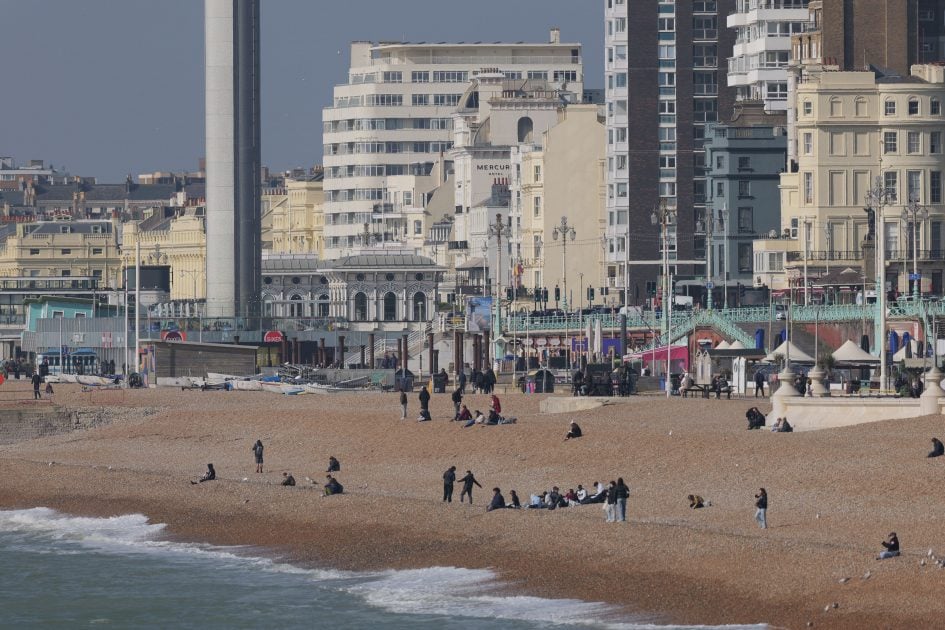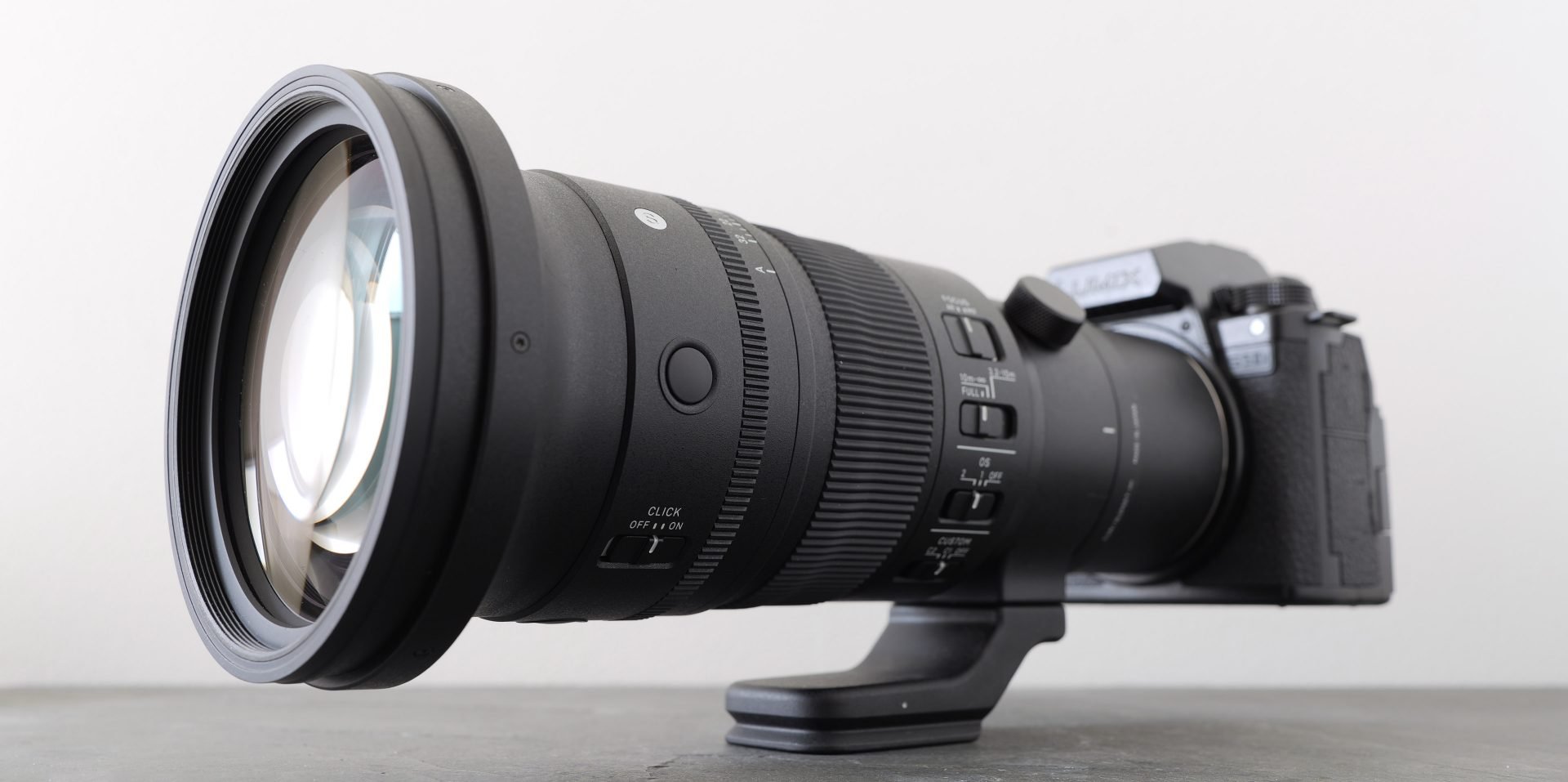Sigma 500mm f5.6 DG DN Sports review
-
-
Written by Gordon Laing
Intro
The Sigma 500mm f5.6 DG DN OS Sports is a light and compact super-telephoto prime lens aimed at sports, wildlife and aviation photographers. Announced in March 2024 and initially available in Sony-e and Leica L-mounts, it costs around $3000 or £2800. Price-wise this pitches it roughly between a variety of super-telephoto zooms and super-high-end prime lenses, while beating them all on portability.
Size and weight are key benefits here, with the Sigma 500mm f5.6 being surprisingly small and light in person, measuring just 235mm long, 108mm in diameter, and weighing just under 1.4kg. That’s actually shorter and only a tad heavier than Canon’s legendary EF 400 5.6 despite reaching 100mm further.
It’s seriously compact and lightweight for a lens of this focal length and aperture, and something I found I could comfortably handhold and walk around with all day. I even managed to use it on my Feisol TT-15 mini tripod. Find out everything you need to know about the Sigma 500 f5.6 in my review video below, or if you prefer to read the written highlights, keep scrolling!
Compared to the 500 5.6, Sigma’s own 150-600 and 60-600 zooms may be a much more affordable way to reach 500mm and beyond, costing around $1500 and $2000 respectively, but both are dimmer at 500mm and crucially a lot heavier at 2.1 and just under 2.5kg respectively. Meanwhile Sony’s popular FE 200-600 is another more affordable way to reach 500mm at around $2000, but again is a more substantial proposition, longer at 318mm, heavier at 2.1kg, and dimmer at 500mm.
By now you’ll be understanding the USP of the Sigma 500 prime. It may be more expensive than a zoom and obviously lacks their flexibility, but counters it with a slightly brighter aperture, shorter length, and considerably lighter weight, not to mention the promise of better quality.
Suffice it to say it’s also a lot lighter and more affordable than the truly high-end f2.8 and f4 primes out there, thereby delivering an aspirational package without breaking your back. And while three grand can’t be described as cheap, it is around a quarter of the price of those mega lenses.
Ok that’s enough background, let’s take a tour around the lens. Designed, manufactured and assembled at Sigma’s sole factory in Japan, the build quality is excellent. The lens is made from what Sigma describes as a Thermally Stable Composite material which shares similar expansion properties to aluminium. The mount, control rings and switches are all dust and splash resistant. As you’d hope, the lens is supplied with a tripod collar and foot, and as always, bonus points to Sigma for carving an Arca-Swiss dovetail in the foot, allowing it to slide right into compatible clamps. Other companies please take note and follow-suit.
The foot can be removed to save a little weight, but I left it on to double as a handle, albeit quite a tight one for those with larger hands. The collar remains integrated, allowing the barrel to rotate inside, with useful notches and feedback at 90 degree intervals.
Closest to the mount are four switches, the first for auto and manual focus. Below this is the focus limiter with three options: the Full range, 10m to infinity for distant subjects, or 3.2 to 10m for closer ones. Next comes the Optical Stabilisation switch with two modes, one for general use and the other optimised for panning. Most bodies with IBIS can work alongside it, with the lens typically taking care of the X and Y stabilisation, leaving other axes to the camera.
Below this is the custom switch with two banks. Like other Sigma lenses with the same capability, this allows you to fine-tune stabilisation and focus limiter options via the optional USB Dock. This is however only available for L-mount versions of the lens, so Sony owners will have to make do with the defaults.
Positioned roughly mid-way along the barrel is a wide and very smooth, free-spinning manual focusing ring, followed by a manual aperture ring closer towards the front of the lens. At first it looks unusual to have this ring so far from the mount, but it makes sense as this is where you’ll support the lens when shooting. The aperture runs between f5.6 and f32, with a lockable A position for body-based control. The aperture ring can also be clicked or de-clicked by a switch on the opposite side. Finally towards the end of the barrel are three focus hold buttons, normally also customisable on most bodies.
Unsurprisingly for this focal length and aperture, the front of the barrel expands to accommodate the first element, with an equally substantial 95mm filter thread at the end. Sigma supplies a clip-on plastic cap and a substantial cylindrical hood which is held in place by a thumbscrew. Note the rubber tip to the hood, which allows you to stand the lens up on a flat surface with less risk of slipping. The depth of the hood also keeps the precious front element protected from uneven surfaces, and the hood itself can be reversed over the barrel for transportation.
Sigma also includes a padded case for the lens with swappable bases depending whether you carry the lens with the hood reversed over the barrel or removed altogether. Like most cases for big lenses though, you will have to remove your camera body if you want to zip it closed.
Sigma supplied the L-mount version for my review, and I used the Panasonic Lumix S5 IIx to test it. The optical results should apply to the e-mount version for the Sony owners out there.
One of the quirks of Lumix bodies is they sometimes slow their photo autofocus when connected to an external HDMI recorder, which makes it hard to demonstrate in a review like this. So anecdotally, I found the focus swift in use, limited only by the subject recognition and tracking of the body you mount it on.
I can however show you the effect of stabilisation in practice. Here I’m trying to frame a tree at the end of my garden, first without stabilisation, before switching it on via the lens barrel and returning to a view that after a couple of seconds becomes much steadier.
Here’s a more challenging situation where I’m holding the camera and lens high above my head for a clear view of the bird through the branches. It’s an uncomfortable position with inevitable wobbles, but the OS still let me grab some sharp images.
And now I’ve relocated to a position where I could lean against a wall. It’s still handheld, but clearly much steadier thanks to an extra point of contact. If you intend to pan, I’d strongly recommend OS Mode 2, otherwise the image can jump as you reach the extremes
Next for coverage, and for comparison I’ll start with the view of Brighton Pier from my earlier review of the Sigma 50mm f1.4 DG DN Art lens, so this represents standard coverage.
And now what you’ll get from the 500 5.6 from the same position. I also scaled this down to match the details on the 50 and found I could fit a fraction under ten of them across the frame of that shorter lens, confirming the magnification.
Most obviously 500mm is an ideal length for bird photography and distant sports, but I also enjoy the unique perspective super-telephotos can deliver on urban views. The compression can be quite dramatic and I have more examples on my samples page.

It’s also a decent length for solar and lunar photography. Sadly the Moon was elusive during my test period, but I did grab some views at sunset. This could also be ideal for eclipse photography.

If you want greater reach, the L-mount version of the lens is compatible with Sigma’s 1.4 and 2x tele-converters, but sadly the Sony version won’t work with TCs, at least not with AF. This could be a reason for Sony owners to choose a Sony lens instead, which also tend to work better with their body’s built-in stabilisation and support the fastest burst speeds.
Or you could mount the lens on a camera with an APSC sensor or exploit a cropped mode to deliver an effective focal length of 750mm. While crop modes will reduce the resolution of still photos, many cameras offer cropped video modes which maintain 4k quality.
Soo illustrate the extra reach in action, here’s a still photo of the Sun in full-frame mode, and now for a short video clip filmed in a 4k APSC mode for a 50% boost in magnification. This was also handheld.
This trick is also great for a boost on wildlife. So here’s that pigeon again, with full-frame coverage, before switching to a 4k video version. As mentioned earlier, I was leaning against a wall here, but this was still handheld at 750mm equivalent.
I’ll show you some more videos later, but first let’s check out the photo quality of the 500 5.6 on another portion of Brighton Pier, and since the view’s already so tight, there’s no need to angle it as I do with wider lenses.
Let’s zoom into the middle for a closer look with the aperture wide-open to f5.6, where there’s lots of fine details and nothing to complain about. In my tests I saw no benefit to closing the aperture further for sharpness in the middle.
Heading into the far corner tells the same story. The sharpness is maintained right into the extremes with the aperture wide-open, and again there’s no benefit to stopping it down in my tests. This represents excellent performance from the Sigma 500 and confirms its optical superiority over cheaper zooms.
This quality is also maintained at closer distances, although the modest minimum focusing distance of 3.2m does limit the potential magnification compared to rival zooms. But here’s an example near to the minimum focusing distance, allowing me to almost fill the frame with this bird.

Let’s have a look at some more bird photos taken with the lens mounted on the S5 IIx body, generally using zone or full area AF with Animal and Human subject recognition. As the birds pass in front of buildings, you’ll see the potential for separation at f5.6. Sure it’s not as great as an f4 or f2.8 super-tele prime, but again this lens is considerably lighter and cheaper than those options.
And coming from the other direction, it may be more expensive and lack the flexibility of a zoom, but I greatly appreciated its considerably lighter weight when moving around, especially as it remained a hand-holdable prospect in many situations.
My results from the 500 were also a little sharper and with slightly shallower depth of field effects than the best zooms out there. The Lumix S5 IIx autofocus and tracking though was not as reliable or consistent as the Sony bodies I’ve tested, so L-mount bird photographers may want to try before they buy.
Check prices on the Sigma 500mm f5.6 DG DN Sports at B&H, Adorama, WEX UK or Calumet.de. Alternatively get yourself a copy of my In Camera book, an official Cameralabs T-shirt or mug, or treat me to a coffee! Thanks!
 The Sigma 500mm f5.6 DG DN is a very welcome super-telephoto lens for those who prefer to use primes over zooms. It delivers a step-up in sharpness and brightness over the big zooms, with a considerable saving in weight, making it tempting to anyone shooting distant subjects who values portability. At just under 1.4kg, it’s much easier to carry around than zooms which include this focal length, and unlike those models, I found it possible to shoot all day mostly handheld without the need for a tripod or monopod. And while it lacks the ultimate separation of the f4 and f2,.8 super-tele primes, it’s considerably lighter and cheaper than any of them. But there’s no getting away from the fact it’s pricier than the big zooms, while also lacking their flexibility. Sigma’s own 60-600 and 150-600 both extend beyond 500mm, giving them greater compositional flexibility while also costing two thirds and half the price respectively. Likewise, Sony’s 200-600 reaches further, has greater flexibility and costs two thirds the price of the Sigma prime. But all are larger and weigh over 2kg, or in the case of the 60-600, closer to two and a half kilograms, making them much less portable. When testing them, I loved their flexibility and affordability, but hated carrying any of them for long. Ultimately there’s lots of choice, and I’m delighted Sigma has targeted the middle ground, a little like Canon’s old 400 5.6 and Nikon’s recent 600 6.3. All offer a taste of a bright super-telephoto prime without the cost and weight of those you see lugged around pro sport venues.
The Sigma 500mm f5.6 DG DN is a very welcome super-telephoto lens for those who prefer to use primes over zooms. It delivers a step-up in sharpness and brightness over the big zooms, with a considerable saving in weight, making it tempting to anyone shooting distant subjects who values portability. At just under 1.4kg, it’s much easier to carry around than zooms which include this focal length, and unlike those models, I found it possible to shoot all day mostly handheld without the need for a tripod or monopod. And while it lacks the ultimate separation of the f4 and f2,.8 super-tele primes, it’s considerably lighter and cheaper than any of them. But there’s no getting away from the fact it’s pricier than the big zooms, while also lacking their flexibility. Sigma’s own 60-600 and 150-600 both extend beyond 500mm, giving them greater compositional flexibility while also costing two thirds and half the price respectively. Likewise, Sony’s 200-600 reaches further, has greater flexibility and costs two thirds the price of the Sigma prime. But all are larger and weigh over 2kg, or in the case of the 60-600, closer to two and a half kilograms, making them much less portable. When testing them, I loved their flexibility and affordability, but hated carrying any of them for long. Ultimately there’s lots of choice, and I’m delighted Sigma has targeted the middle ground, a little like Canon’s old 400 5.6 and Nikon’s recent 600 6.3. All offer a taste of a bright super-telephoto prime without the cost and weight of those you see lugged around pro sport venues.



